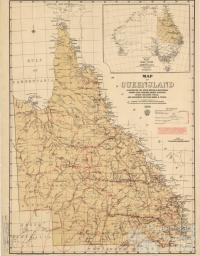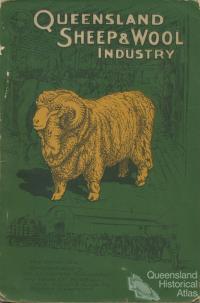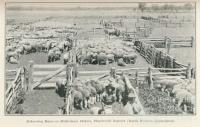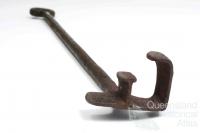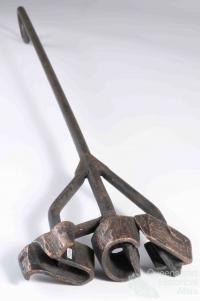- Home
- Quintessential Queensland
- Distinctiveness
- Perceptions
- Perceptions: how people understand the landscape
- From runs to closer settlement
- Geological survey of Queensland
- Mapping a new colony, 1860-80
- Mapping the Torres Strait: from TI to Magani Malu and Zenadh Kes
- Order in Paradise: a colonial gold field
- Queensland atlas, 1865
- Queensland mapping since 1900
- Queensland: the slogan state
- Rainforests of North Queensland
- Walkabout
- Queenslanders
- Queenslanders: people in the landscape
- Aboriginal heroes: episodes in the colonial landscape
- Australian South Sea Islanders
- Cane fields and solidarity in the multiethnic north
- Chinatowns
- Colonial immigration to Queensland
- Greek Cafés in the landscape of Queensland
- Hispanics and human rights in Queensland’s public spaces
- Italians in north Queensland
- Lebanese in rural Queensland
- Queensland clothing
- Queensland for ‘the best kind of population, primary producers’
- Too remote, too primitive and too expensive: Scandinavian settlers in colonial Queensland
- Distance
- Movement
- Movement: how people move through the landscape
- Air travel in Queensland
- Bicycling through Brisbane, 1896
- Cobb & Co
- Journey to Hayman Island, 1938
- Law and story-strings
- Mobile kids: children’s explorations of Cherbourg
- Movable heritage of North Queensland
- Passages to India: military linkages with Queensland
- The Queen in Queensland, 1954
- Transient Chinese in colonial Queensland
- Travelling times by rail
- Pathways
- Pathways: how things move through the landscape and where they are made
- Aboriginal dreaming paths and trading ways
- Chinese traders in the nineteenth century
- Introducing the cane toad
- Pituri bag
- Press and the media
- Radio in Queensland
- Red Cross Society and World War I in Queensland
- The telephone in Queensland
- Where did the trams go?
- ‘A little bit of love for me and a murder for my old man’: the Queensland Bush Book Club
- Movement
- Division
- Separation
- Separation: divisions in the landscape
- Asylums in the landscape
- Brisbane River
- Changing landscape of radicalism
- Civil government boundaries
- Convict Brisbane
- Dividing Queensland - Pauline Hanson’s One Nation Party
- High water mark: the shifting electoral landscape 2001-12
- Hospitals in the landscape
- Indigenous health
- Palm Island
- Secession movements
- Separate spheres: gender and dress codes
- Separating land, separating culture
- Stone walls do a prison make: law on the landscape
- The 1967 Referendum – the State comes together?
- Utopian communities
- Whiteness in the tropics
- Conflict
- Conflict: how people contest the landscape
- A tale of two elections – One Nation and political protest
- Battle of Brisbane – Australian masculinity under threat
- Dangerous spaces - youth politics in Brisbane, 1960s-70s
- Fortress Queensland 1942-45
- Grassy hills: colonial defence and coastal forts
- Great Shearers’ Strike of 1891
- Iwasaki project
- Johannes Bjelke-Petersen: straddling a barbed wire fence
- Mount Etna: Queensland's longest environmental conflict
- Native Police
- Skyrail Cairns (Research notes)
- Staunch but conservative – the trade union movement in Rockhampton
- The Chinese question
- Thomas Wentworth Wills and Cullin-la-ringo Station
- Separation
- Dreaming
- Imagination
- Imagination: how people have imagined Queensland
- Brisbane River and Moreton Bay: Thomas Welsby
- Changing views of the Glasshouse Mountains
- Imagining Queensland in film and television production
- Jacaranda
- Literary mapping of Brisbane in the 1990s
- Looking at Mount Coot-tha
- Mapping the Macqueen farm
- Mapping the mythic: Hugh Sawrey's ‘outback’
- People’s Republic of Woodford
- Poinsettia city: Brisbane’s flower
- The Pineapple Girl
- The writers of Tamborine Mountain
- Vance and Nettie Palmer
- Memory
- Memory: how people remember the landscape
- Anna Wickham: the memory of a moment
- Berajondo and Mill Point: remembering place and landscape
- Cemeteries in the landscape
- Landscapes of memory: Tjapukai Dance Theatre and Laura Festival
- Monuments and memory: T.J. Byrnes and T.J. Ryan
- Out where the dead towns lie
- Queensland in miniature: the Brisbane Exhibition
- Roadside ++++ memorials
- Shipwrecks as graves
- The Dame in the tropics: Nellie Melba
- Tinnenburra
- Vanished heritage
- War memorials
- Curiosity
- Curiosity: knowledge through the landscape
- A playground for science: Great Barrier Reef
- Duboisia hopwoodii: a colonial curiosity
- Great Artesian Basin: water from deeper down
- In search of Landsborough
- James Cook’s hundred days in Queensland
- Mutual curiosity – Aboriginal people and explorers
- Queensland Acclimatisation Society
- Queensland’s own sea monster: a curious tale of loss and regret
- St Lucia: degrees of landscape
- Townsville’s Mount St John Zoo
- Imagination
- Development
- Exploitation
- Transformation
- Transformation: how the landscape has changed and been modified
- Cultivation
- Empire and agribusiness: the Australian Mercantile Land and Finance Company
- Gold
- Kill, cure, or strangle: Atherton Tablelands
- National parks in Queensland
- Pastoralism 1860s–1915
- Prickly pear
- Repurchasing estates: the transformation of Durundur
- Soil
- Sugar
- Sunshine Coast
- The Brigalow
- Walter Reid Cultural Centre, Rockhampton: back again
- Survival
- Survival: how the landscape impacts on people
- Brisbane floods: 1893 to the summer of sorrow
- City of the Damned: how the media embraced the Brisbane floods
- Depression era
- Did Clem Jones save Brisbane from flood?
- Droughts and floods and rail
- Missions and reserves
- Queensland British Food Corporation
- Rockhampton’s great flood of 1918
- Station homesteads
- Tropical cyclones
- Wreck of the Quetta
- Pleasure
- Pleasure: how people enjoy the landscape
- Bushwalking in Queensland
- Cherbourg that’s my home: celebrating landscape through song
- Creating rural attractions
- Festivals
- Queer pleasure: masculinity, male homosexuality and public space
- Railway refreshment rooms
- Regional cinema
- Schoolies week: a festival of misrule
- The sporting landscape
- Visiting the Great Barrier Reef
By:
Geoff Ginn After two decades of land seizure and frontier bloodshed, by 1859 the pastoral grazing of sheep and cattle had completely transformed at least a quarter of the land use in Queensland and had become the cornerstone of the colonial economy. Three and a half million sheep and some 500,000 cattle grazed across a quarter of the colony’s land mass, and pastoral concerns generated 70 per cent of revenue and over 90 per cent of exports. ‘Wool, tallow, and hides are the great staple products of our colony’, observed the Brisbane Courier in 1861. ‘Upon the successful working of the princely properties on which this produce is raised depends...the growth and stability of the wealth of the country’.
Pastoral expansion was the barometer of Queensland’s growth and prosperity, and it also became a primary mode for viewing the landscape. Edward Palmer lauded the inexorable spread of his fellow pioneers on their ‘mission’ to establish grazing runs in 1903:
Through the brigalow and mulga scrubs, dense and forbidding, over mountain ranges, stony and steep, across flooded rivers, and over or around all obstacles, the pioneers still moved on and took up and occupied runs. Westward to the Maranoa and Warrego, and northward by the Fitzroy to the Burdekin and Flinders River... their mission was carried on, to fill the land with the outposts of civilisation.
In 1860 the ‘princely properties’ of the squatters were set for a boom era. Generous land regulations introduced that year permitted one-year licenses on properties or ‘runs’ of one hundred square miles and fourteen-year leases as long as the run was promptly stocked to a quarter of its capacity. By the end of that decade only Cape York Peninsula and the far west were unoccupied.
Much of the expansion was driven by Victorian wealth re-invested in Queensland pastoral properties. But with the economic downturn of 1866, commercial uncertainty and the flow of capital drying up, many squatters went bust. As Palmer saw it in 1903, pastoral expansion ‘was instantly checked, and the outward flow of civilisation turned backwards’.
Thereafter four fundamental changes consolidated the industry in the course of the 1870s and 1880s. On the land, cheap wire fencing constrained herds and thus reduced the need for shepherds, while the tapping of artesian water after 1880 reduced reliance on fickle creeks and billabongs. The extension of railways permitted stock to be trucked to processing works on the coast and more efficient despatch of the wool clip. Finally, the development of refrigeration technology after 1883 meant that shipments of beef and mutton could be made to overseas markets. Although initially beset by technical problems, freezing works for export put the Queensland cattle industry onto a lucrative and sustainable footing for the first time.
Limits to growth?
Pride in the grazing industry became a hallmark of Queensland identity. Sheep numbers peaked at an incredible 21 million by 1892, and cattle at seven million shortly afterwards, as most observers lauded the boundless potential of Queensland’s grazing country. Drought, dust-storms, strike action, economic depression and tick fever brought new challenges through the 1890s, but with Federation the pastoral character of the state’s inland districts was well-established. Artesian water seemed to guarantee pastoral prosperity, ‘whilst the origin of these subterranean stores is still somewhat of a mystery’, declared the Jubilee memorial volume in 1909, ‘they are apparently inexhaustible’. By 1913 the Government’s Intelligence and Tourist Bureau could describe the state as ‘the greatest cattle-raising country in the Commonwealth of Australia’, trumpeting that ‘her herds are the largest, her cattle stations are the most extensive, and the aggregation of her pastoral areas considerably exceed those in any of the other States’.
Queensland’s sheep and cattle properties covered a vast extent, especially in the north-west. From Richmond to Cloncurry, reported the Intelligence and Tourist Bureau in 1913, ‘then out to Camooweal on the borders of the Northern Territory, and thence to Burketown, [the pastoral runs] range from 2,000 to 5,000 square miles, and carry from 10,000 to nearly 50,000 head of cattle’. ‘Warenda’ in the Gregory North district was the largest, followed by Dalgonally near Julia Creek, Millungera and Taldora in the Gulf, Fort Constantine near Cloncurry district and Lawn Hills in the Burke district. All ran 30,000 head of cattle or more; nearly 70 other stations ran between 10,000-30,000 each.
Movement and mobility
Initially overland movements were haphazard and opportunistic, but in time railway routes to shift livestock, and gazetted water and camp reserves and stock routes, made them more certain. By the early 1880s, a network of these stock routes converged on railheads, where cattle were loaded for transport to abattoirs on the coast. Drovers led large mobs of cattle from the west of the state across great distances, some down to Bourke and from there to Sydney while others favoured Oodnadatta in South Australia, to be railed to Adelaide or Melbourne.
Workers had to travel great distances to earn a living, the classic example being the itinerant shearers who worked at contract rates from shed to shed during the shearing season. Epic overland drives of ‘fats’ and ‘stores’ and the peculiar pleasures of a solitary life in the saddle were likewise the stuff of rural legend. ‘Droving has its advantages as well as its disadvantages’, commented the Intelligence and Tourist Bureau in 1913,
When climatic conditions are favourable, grass and water plentiful, and the cattle contented, the lot of the drover and his stock-hands is, though of a strenuous nature at all periods of the trip, not without its attractive features. Taken on the whole, it is a very healthy occupation, and there is also a great deal of adventure attached to it.
References and Further reading (Note):
Edward Palmer, Early days in North Queensland, Sydney, Angus & Robertson, (1903) 1983
References and Further reading (Note):
Our first half-century: a review of Queensland progress (Jubilee Memorial Volume) Brisbane, Government Printer, 1909
References and Further reading (Note):
Noela Corfield, ‘The Development of the Cattle Industry in Queensland 1840-1890’, BA (Hons) thesis, University of Queensland, 1959
References and Further reading (Note):
B.R. Kingston, ‘Theory and practice in the pastoral settlement of Queensland, 1859-1869’, BA (Hons) thesis, University of Queensland, 1963

